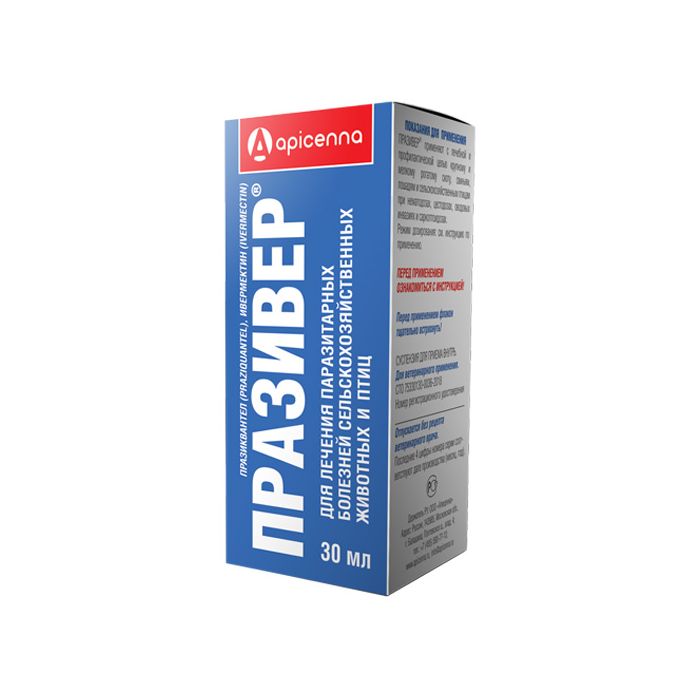Praziver 30ml
DESCRIPTION
Praziver is a broad-spectrum antiparasitic drug for farm animals and poultry in the form of an oral suspension. Dosage form: suspension for oral administration. In appearance, the drug is a white to cream suspension.
COMPOSITION AND FORM OF ISSUE
Praziver in 1 ml contains as active ingredients: praziquantel - 25 mg, ivermectin - 5 mg and excipients: Na-carboxymethyl cellulose, xanthan gum, potassium sorbate, glycerin, tween-80 and purified water.
PHARMACOLOGICAL PROPERTIES
Praziver is a highly effective combination of well-known anthelmintics.
Praziquantel and ivermectin provide a broad spectrum of antiparasitic action of Praziver against helminths, sarcoptoid mites, insects and gadfly larvae. Praziquantel is a synthetic isoquinolinepyrazine derivative that is active against sexually mature and immature forms of tapeworms. Its mechanism of action is based on impaired permeability of helminth membranes, damage to the outer shell, persistent depolarization of muscle cells, impaired energy metabolism, which causes a generalized contraction of the muscles, turning into persistent paralysis, leading to the death of cestodes. Ivermectin is a compound of the class of macrocyclic lactones that is active against the imaginal and larval phases of development of nematodes of the gastrointestinal tract and lungs, sarcoptoid mites, insects and gadfly larvae. The main targets of ivermectin action are glutamate-sensitive chlorine channels, as well as gamma-aminobutyric acid receptors. A change in the current of chlorine ions through the membranes of nerve and muscle cells disrupts the conduction of impulses, which leads to paralysis and death of parasites. Praziquantel and ivermectin are well absorbed in the gastrointestinal tract, reaching maximum plasma concentrations 4-6 hours after oral administration of the drug, undergo biotransformation in the body, excreted mainly in the urine, as well as in feces, in lactating animals - partially with milk ... Praziver, in terms of the degree of impact on the body, belongs to moderately hazardous substances (hazard class 3 according to GOST 12.1.007-76), in the recommended doses it does not have embryotoxic, teratogenic and sensitizing effects,
INDICATIONS
Prescribed for therapeutic and prophylactic purposes in large and small ruminants, pigs, horses and poultry with nematodes, cestodes, gadfly invasions and sarcoptoidosis.
DOSES AND METHOD OF APPLICATION
For cattle and horses, the suspension is used individually, for sheep and goats - individually or in a group way in a mixture with concentrated feed for nematodes of the gastrointestinal tract (hemonhoz, bunostomosis, esophagostomosis, nematodyrosis, habertiosis, cooperiosis, ostertascyliasis, trichylostyloidosis ), nematodes of the lungs (dictyocaulosis, mulleriosis, cystocaulosis, protostrongylosis), cestodoses, with hypodermatosis, gastrofillosis and sarcoptoidosis at a dose of 0.4 ml per 10 kg of animal weight.
Small ruminants with estrosis are prescribed at the rate of 0.6 ml of suspension per 10 kg of animal weight. With the group method, the amount of the drug, calculated for a group of sheep or goats (but not more than 100 heads), is mixed with concentrated feed at an average rate of 150-200 g of feed per animal.
Preventive deworming of animals is carried out before stalling and in spring, before pasture, treatment against gadfly larvae - immediately after the end of their summer, once, with sarcoptoidosis (sarcoptic mange, psoroptosis, chorioptosis) - according to indications twice with an interval of 7-12 days.
For pigs, Praziver is used individually or in groups with concentrated feed at a dose of 0.6 ml per 10 kg of animal body weight. In case of nematodosis (ascariasis, esophagostomosis, metastrongylosis, trichocephalosis, strongyloidosis), animals are dewormed once, with sarcoptic mange they are treated twice with an interval of 7 to 10 days. With the group method, the amount of the drug calculated for a group of pigs (but not more than 50 heads) is mixed with half the feed rate and laid out in the feeders, providing the animals with free access to them.
For broilers, replacement chickens, Praziver is used no later than 2 weeks before the start of egg-laying; geese and ducks with nematodes (ganguleteracidosis, ascariasis, heterocytosis) and cestodosis (drepanidotheniosis, hymenolepiasis, ryetinosis). The bird is given the drug individually or in a group way mixed with food in the morning feeding at a dose of 0.2 ml per 1 kg of body weight. Before use, the bottle with the drug should be shaken thoroughly for 1 - 2 minutes. Before mass treatments, each batch of the drug should be tested on a small group of animals (5 - 7 heads) of different age and weight. In the absence of complications within 3 days, they begin to process the entire livestock.
SIDE EFFECTS
In rare cases, with increased individual sensitivity in animals and with an overdose, nausea, vomiting, soreness in the epigastric region, diarrhea mixed with blood, dizziness, drowsiness, allergic reactions in the form of skin rashes and itching are possible. In these cases, the use of the drug is discontinued, the animals are prescribed symptomatic and desensitizing therapy.
CONTRAINDICATIONS
Individual hypersensitivity to drug components. Laying hens (due to the accumulation of ivermectin in eggs), rearing hens, less than 2 weeks before the start of egg-laying, milking hens, as well as pregnant females, less than 28 days before delivery, exhausted, sick with infectious diseases and recovering animals.
SPECIAL INSTRUCTIONS
STORAGE CONDITIONS
In a dry place, protected from direct sunlight and out of reach of children and animals. Separated from food and feed in the manufacturer's packaging at a temperature of 2 to 25 В° C. The shelf life is 3 years.
PACKAGING
The drug is released in 30 ml bottles.
Specifications
Item segment
New
Bonus points
0
KolVUP
50
Manufacturer
APICENNA
Teaser
highly effective combination of well-known anthelmintics

